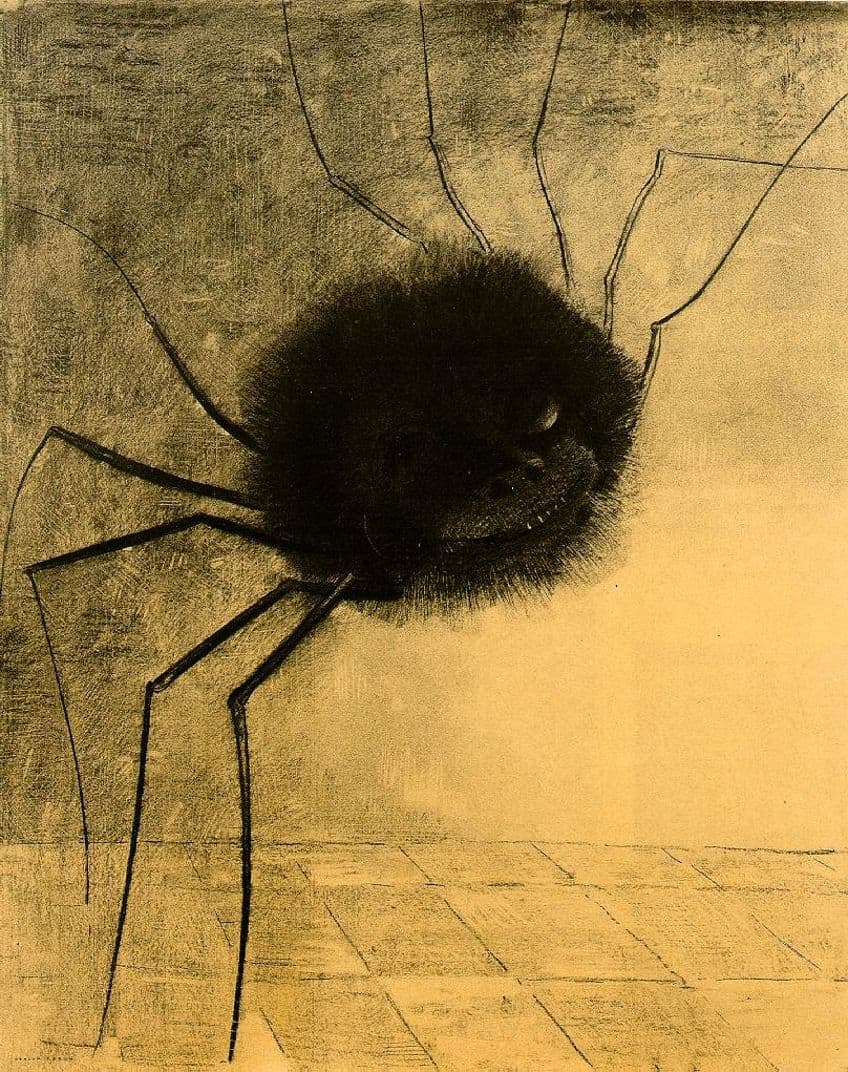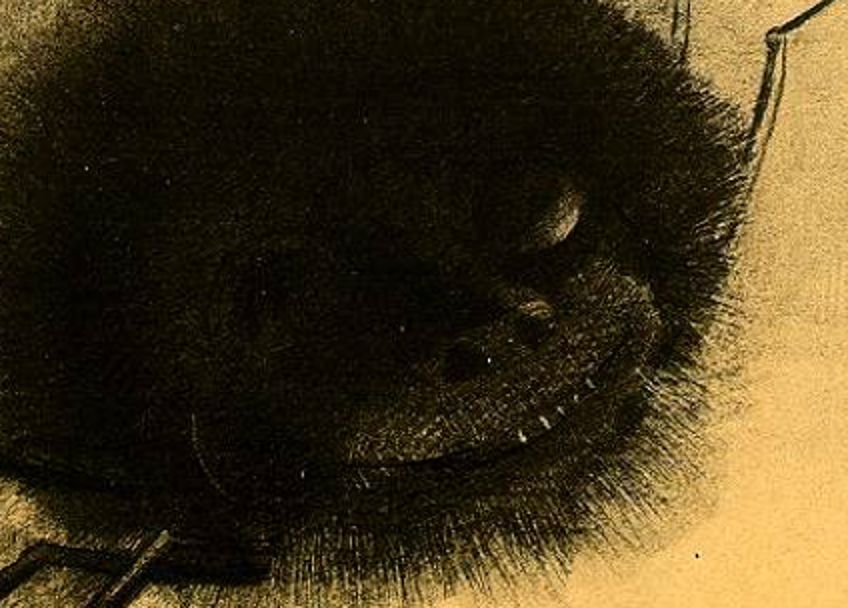“The Smiling Spider” by Odilon Redon – A Creepy Painting Analysis
Odilon Redon’s The Smiling Spider is a captivating and eerie piece that exemplifies the artist’s mastery of symbolism and the fantastical. Created in 1881, this charcoal drawing showcases Redon’s ability to blend the grotesque with the whimsical, presenting a surreal image of a spider with an unnervingly human smile. This artwork reflects Redon’s fascination with dreams and the subconscious, drawing viewers into a world where the boundaries between reality and imagination blur. The Smiling Spider stands as a testament to Redon’s unique vision and his contribution to the Symbolist movement, challenging conventional perceptions of beauty and horror.
Key Takeaways
- The Smiling Spider is a Symbolist artwork by Odilon Redon from 1881.
- The piece features a human-faced spider and is emblematic of Redon’s fascination with the macabre.
- His work often merges scientific curiosity with artistic creativity.
Odilon Redon: Historical Context
| Artist | Odilon Redon (1840 – 1916) |
|---|---|
| Date Created | 1881 |
| Medium | Charcoal on paper |
| Genre | Symbolism |
| Period/Movement | Symbolism |
| Dimensions (cm) | 49.5 × 39 |
| Series/Versions | Single version |
| Where Is It Housed? | Musée du Louvre, Paris, France |
| What It Is Worth | Not publicly auctioned; significant cultural and historical value |
Odilon Redon’s The Smiling Spider, created in 1881, is a captivating piece of the Symbolist movement. The artwork, made with charcoal, showcases Redon’s unique ability to blend the eerie with the imaginative. It features a human-faced spider with an unsettling grin, drawing viewers into a world where the ordinary becomes extraordinary. This piece is currently housed in the Musée du Louvre in Paris, reflecting its significant impact on art history.

Redon was known for his fascination with the unconventional and the macabre. His artwork often included fantastical creatures such as cyclopes and human-headed plants. The Smiling Spider is no exception, inviting viewers to ponder the deeper mysteries of their own minds. Redon’s approach to color and form in this piece emphasizes the symbolic nature of his work more than the literal representation. His insistence on grappling with themes of darkness and imagination makes his work stand out in the Symbolist genre. Moreover, Redon’s works, including The Smiling Spider, often drew inspiration from science and nature. He found beauty in the strange and the grotesque, reflecting the scientific curiosity of his time. This ability to merge scientific observation with artistic creativity is what sets Redon apart from his contemporaries.
In doing so, he created pieces that resonate with viewers long past their creation.
Development as a Symbolist Artist
Odilon Redon’s development as an artist began in 1878 when he started to gain recognition for his unique approach. The Symbolism movement, which aimed to express ideas and emotions rather than realistic representations, became the perfect outlet for his creativity. Redon’s work frequently depicted fantastic and dreamlike scenes, often using dark themes and haunting imagery. His charcoal drawings, or “noirs,” as they are commonly known, are some of his most celebrated works, showcasing his skill in creating mood and depth. As he progressed, Redon also began to incorporate pastels and oils, expanding his range of expression. His art evolved from the dark, monochromatic tones of his early work to more vibrant and colorful pieces later in his career. Despite the shift in media and color, his focus on imagination and visionary themes remained constant.

Influences and Contributions to Modern Art
Odilon Redon was influenced by various artists and writers of his time. He was particularly inspired by the works of Edgar Allan Poe and Charles Baudelaire, whose themes of mystery and the inner workings of the mind resonated with Redon’s own artistic goals. His friendship with the botanist Armand Clavaud also had a significant impact, as it introduced him to the detailed and often surreal imagery of the natural world. Redon’s contributions to modern art were considerable. He is often credited with bridging the gap between Symbolism and later movements like Expressionism and Surrealism. His emphasis on dreams and the subconscious prefigured the works of later artists, such as Salvador Dalí and Max Ernst.
Redon’s ability to convey complex emotions and visions through his unique style has left a lasting legacy in the art world.
Analyzing The Smiling Spider
The Smiling Spider by Odilon Redon is a mysterious and evocative piece. It captivates with its strange imagery and use of dark, intricate techniques. The work falls under Symbolism and offers rich layers for interpretation.

Artistic Techniques and Mediums
The Smiling Spider was created using charcoal, a medium known for its deep, rich blacks. Charcoal allows for soft shading and strong contrasts, contributing to the eerie ambiance of the piece. Redon also created versions of this artwork as lithographs. The spider’s ten legs are shown in detailed, precise lines.
The background suggests a three-dimensional space, though it remains vague, enhancing the dream-like quality.

Symbolism and Imagery
Symbolism is at the core of The Smiling Spider. The creature’s humanoid face, complete with a wide grin and tiny teeth, evokes both amusement and unease. This blending of human and spider elements is both bizarre and arresting, reflecting the Symbolist movement’s love for fantasy and dreams. The spider’s body is fuzzy and round, tilting slightly as if it might move at any moment.
This dynamic pose gives the impression of life and motion, adding to the work’s surreal ambiance.

Interpretations and Critical Reception
Critics have interpreted The Smiling Spider as a reflection of Redon’s fascination with the macabre. The piece is seen as embodying deeper emotional and psychological themes. Its grotesque yet whimsical nature invites varied interpretations, from dark humor to the subconscious mind’s darker aspects. The artwork has been praised for its originality and ability to provoke thought. It is housed in the Musée du Louvre in Paris, signifying its importance in art history.
The piece remains an enduring example of Symbolist art, melding technique, emotion, and imagination.

The Influence of Science and Nature on Redon’s Work
Odilon Redon’s fascination with science and nature played a crucial role in his artwork. His detailed representations of otherworldly creatures, especially arthropods like spiders, reflect this influence deeply. Redon was deeply inspired by natural history. He often studied and incorporated elements from botanical and zoological illustrations into his work. His keen observation of insects and plants led to the creation of hybrids that appear both natural and fantastical.
In The Smiling Spider, the combination of human and arachnid features exemplifies this blend of reality and imagination.
The spider’s intricate legs and fuzzy body show a precise attention to detail. Yet, the human-like face adds a layer of symbolism, making the creature appear both familiar and eerie. Using the microscope, Redon could observe minute details of the natural world. This scientific tool allowed him to explore textures and forms unseen by the naked eye, which he then translated into his drawings. His work often suggests an otherworldly presence, influenced by the unseen details of nature revealed through scientific study.
Depicting the Arthropod
Redon’s depiction of spiders is particularly noteworthy. In The Smiling Spider, he exaggerates certain features to create a striking effect. The spider’s ten legs spread across the page, giving it a commanding presence. The human face embedded in the spider’s body lends an uncanny, almost whimsical quality.
The textures and shadows in his charcoal drawings add depth and realism, making the spider appear both lifelike and surreal. By using contrasts between light and dark, Redon highlights the spider’s fuzzy body and sharp legs, creating a sense of movement.

In The Crying Spider, another famous piece, Redon again merges human emotion with an arthropod form, showcasing his ability to infuse natural elements with emotional complexity. His meticulous study of spiders and their environments informs how he portrays them, emphasizing both their natural structure and their symbolic potential.
Redon’s scientific curiosity and keen observation of the natural world enabled him to create works that are both biologically intriguing and rich in symbolic meaning. Through his unique approach, he brought the hidden details of nature to light in imaginative and thought-provoking ways.
The Smiling Spider encapsulates the artist’s profound engagement with the mysterious and the macabre, inviting viewers to explore the depths of their own subconscious fears and fascinations. This work is a remarkable representation of Redon’s ability to evoke intense emotional responses through his distinctive blend of symbolism and surrealism. By transforming an ordinary creature into a haunting yet intriguing figure, Redon challenges us to reconsider our perceptions of the natural world. Ultimately, The Smiling Spider not only exemplifies Redon’s innovative artistry but also solidifies his legacy as a pioneering force in the Symbolist movement, continuing to captivate and provoke contemplation among art enthusiasts today.
Frequently Asked Questions
What Are the Characteristic Features of The Smiling Spider by Odilon Redon?
The Smiling Spider is a charcoal drawing featuring a spider with a humanoid face. Its ten legs are spread out, making it appear as if dancing. The artwork faintly suggests a floor and wall, adding some three-dimensional space.
How Does The Smiling Spider Fit into Odilon Redon’s Body of Work?
Redon was known for his Symbolist creations, often working in charcoal and lithography. The Smiling Spider fits into his larger collection of noirs, which includes other macabre and fantastical subjects like cyclopes and human-headed plants.
What Techniques Did Odilon Redon Employ in the Creation of The Smiling Spider?
Redon utilized charcoal and lithography to create The Smiling Spider. These techniques allowed him to achieve rich, dark tones and intricate details. His skill in these mediums is evident in the texture and depth seen in the artwork.
Is There a Symbolic Meaning Behind the Imagery in The Smiling Spider?
The spider’s humanoid face and smile may symbolize the blending of human and animal traits, a common theme in Symbolism. The artwork’s eerie tone can evoke deeper thoughts about the nature of humanity and the supernatural.
Isabella studied at the University of Cape Town in South Africa and graduated with a Bachelor of Arts majoring in English Literature & Language and Psychology. Throughout her undergraduate years, she took Art History as an additional subject and absolutely loved it. Building on from her art history knowledge that began in high school, art has always been a particular area of fascination for her. From learning about artworks previously unknown to her, or sharpening her existing understanding of specific works, the ability to continue learning within this interesting sphere excites her greatly.
Her focal points of interest in art history encompass profiling specific artists and art movements, as it is these areas where she is able to really dig deep into the rich narrative of the art world. Additionally, she particularly enjoys exploring the different artistic styles of the 20th century, as well as the important impact that female artists have had on the development of art history.
Learn more about Isabella Meyer and the Art in Context Team.
Cite this Article
Isabella, Meyer, ““The Smiling Spider” by Odilon Redon – A Creepy Painting Analysis.” Art in Context. July 1, 2024. URL: https://artincontext.org/the-smiling-spider-by-odilon-redon/
Meyer, I. (2024, 1 July). “The Smiling Spider” by Odilon Redon – A Creepy Painting Analysis. Art in Context. https://artincontext.org/the-smiling-spider-by-odilon-redon/
Meyer, Isabella. ““The Smiling Spider” by Odilon Redon – A Creepy Painting Analysis.” Art in Context, July 1, 2024. https://artincontext.org/the-smiling-spider-by-odilon-redon/.











